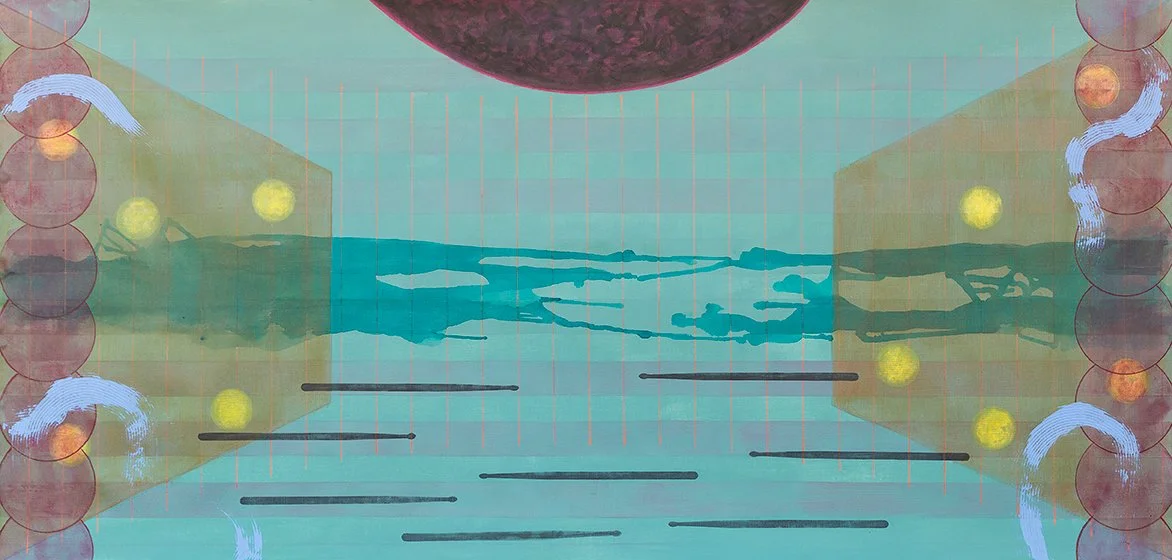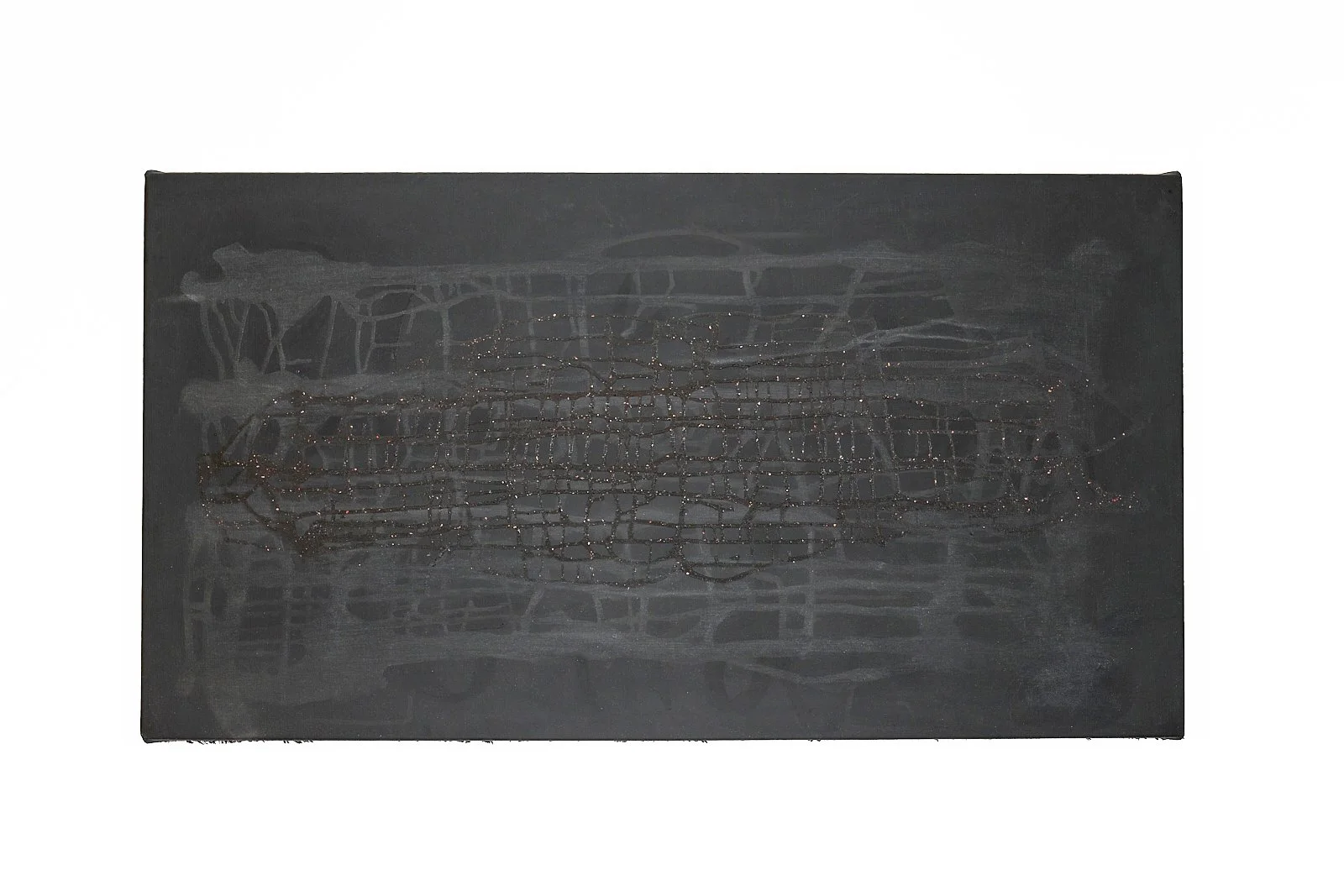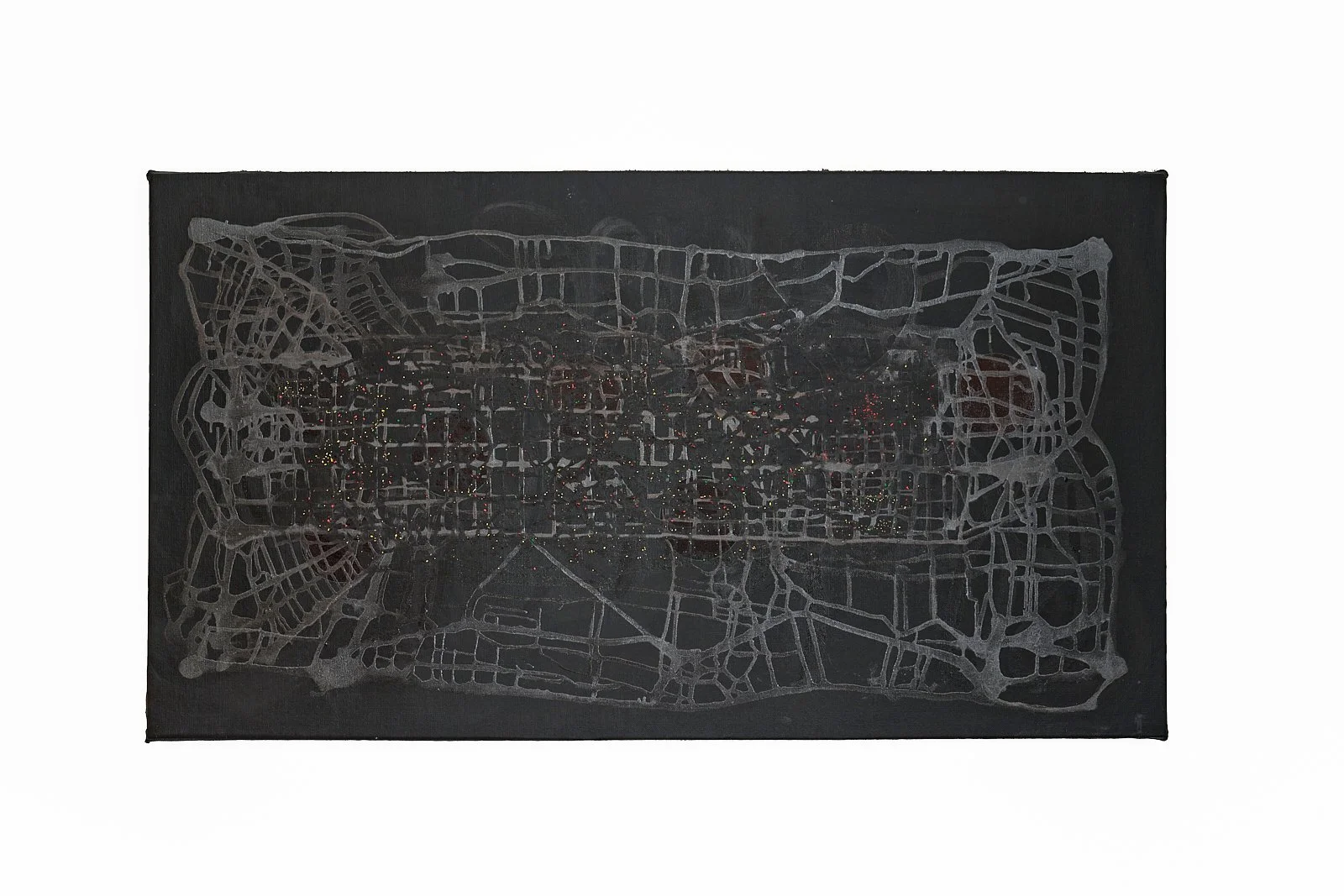Satch Hoyt – Cross Rhythmic Delay
Cross Rhythmic Delay, 2017, acrylic and pigment on canvas
31 May–6 September
Beam, Nottingham
Beam is pleased to present an exhibition of paintings and works on paper by artist and musician Satch Hoyt. The artist’s work is informed by his research into historic colonial representations of African music within museum collections, and the sonic footprint of African music across the diaspora and within contemporary African music culture.
-
The exhibition is underpinned by the artist’s major research project ‘Afro Sonic Mapping – Tracing Aural Histories via Sonic Transmigrations’, which began in 2016, supported by Haus der Kulturen der Welt (HKW) in Berlin, Germany, and the Goethe Institute. The artist’s research traces the migrations of the ‘Afro-Sonic Signifier’, arguing that the enslaved acted as portals carrying various mnemonic networks of sound/Music and seeks to understand its transfer through the Black Atlantic passage as a result of the slave trade. Hoyt investigates the earliest recordings of African music by anthropologists Leo Frobenius, Northcote Thomas and Karl Edvard Laman, among others, who used early phonograph recording machines during their separate field trips in central and West Africa circa 1890 to 1907. The limited nature of this early recording technology captured only a fraction of the music, in particular the high frequencies. The failure to acknowledge the performers and record the context in which the music was made, combined with colonial attitudes, hugely misrepresented the music and culture in the region. In response, Hoyt’s work is in part an attempt to reimagine what is missing by ‘Un-Muting’ the rarely heard antique instruments, incarcerated in the colonial archives of ethnographic museums, which opens a plethora of rarely heard frequencies. From initial research into colonial music archives in the Berliner Phonogramm Archiv and the British Library, London, to connecting with artistic communities in Congo, Angola, Brazil, and Portugal Hoyt's research has led to an extraordinary body of musical collaborations, paintings and sculptures. A detailed account of this work is captured in the artist’s brilliant book ‘Afro Sonic Mapping’ and the artist’s blog.
The centrepiece of the exhibition is ‘Cross Rhythmic Delay’, 2017. The paintings from this series act as ‘cartographic depictions, un-fixed graphics scores and celestial constellations’. On both the left and right of the image are circular and geometric forms with an ocean-like void in the centre. The two sides of the painting are connected by a series of musical stave-like vertical lines, washes and layers of paint and a series of drumsticks that allude to the Black bodies, whose remains constitute the bed of the ocean. The painting in part captures the flow of sonic energy between Africa and the Americas, and depicts the cyclical nature of the movement of music. At the upper centre of the work is a planet pertaining to a reimagined utopian world of ideals. The paintings speak of both geographic and spiritual transit. Multiple transitions which span abduction, racial hybridisation, gender, and spiritual resolve.
The Black Urban Grid series is inextricably linked to Hoyt’s ‘Afro-Sonic Mapping’ paintings and are a visual realisation of the artist’s sonic ‘Un-Muting’ project. The works are imagined cartographic depictions of Black urban communities and cities such as Mbanza City, the capital of Kongo, pre-dating the arrival of the Portuguese in 1483. They are also un-fixed graphic scores, a self-invented music manuscript that functions as real-time compositional directives rather than explicit information, as in Western music notation. The paintings are executed both on the wall and the floor on unstretched canvases. There is an aspect of action painting to these works through the controlled pouring of paint onto the canvas which becomes in itself a form of improvised choreography. The crushed glass and shredded paint allude to the hubbub on the urban landscape and the demography of people, cars, shops and infrastructure. The paintings aim to audibly discombobulate the viewer.
The Spinster series of works on paper also includes a performative aspect in their execution. Hoyt applies pigment to a vinyl 45 and in turn, spins the vinyl onto paper much in the same way as Hip Hop DJ's rhythmically spin vinyl on turntables. The ‘Spins’ are then painted further by hand. This process blurs the boundaries between painting and printmaking and can be considered as performative paintings. Various vintage singles have been used in this process, Aretha Franklin's ‘Chain Of Fools’ and James Brown's ‘The Payback’ to name just two. The large Spinster works were executed with a very scratched thrift store find of the Thelonius Monk LP titled ‘Monk’ on the Prestige label.
-
Satch Hoyt, born in London of British and African-Jamaican ancestry, is currently living and working in Berlin, Germany. He makes sculptures and installations accompanied with sound, as well as paintings and drawings. There is a dichotomy in the genres that define two sides of the same coin: a dual and complementary reflection on the African Diaspora and its multi-fold consequences. The sculptural trope in Hoyt’s work addresses the facts on the ground, so to speak, of black experience, while the drawings tap into a spirit of fantasy, refuge, and transcendence - they are vehicles for an imaginative journey beyond the obduracy and oppressiveness of history.
With regards to his musical accomplishments Satch Hoyt has composed a number of songs with Grace Jones; noteworthy, is 7 Day Weekend which is on the triple platinum soundtrack album of the Eddie Murphy movie Boomerang. Hoyt played flute on Louise Bourgeois’ OTTE, and is flautist - percussionist in Burt Sugar The Arkestra Chamber since 2001. He is currently working on the Un-Muting album from which a limited edition 10inch vinyl will be released on early July 2025 on record label Traza distributed through Honest Jons, a commission by Nottingham Contemporary.
Photograph by Dale Grant
‘When I use the term Un-Muting I am also referencing the Black body as a sonic source, a corporeal resonance chamber, that has internalised, integrated and absorbed centuries of domination subjugation but eloquently answered with invocations to create a sonic canon of cultural encodification and within a trope of conspicuous invisibility retained an unwavering refusal. A haunted portal which has experienced repeated visitations, those visits are inscribed in the antiphonal melodies, the reciting tones, drones and coded rhythms tuned to the frequencies of survival.
The frequencies of survival, polyphonies of reinvention, that I am referring to here, are to be found throughout the trans national African Diaspora. Built Beyond the obduracy of the forced migrations. Instead focused on the retention of spiritual belief and stalwart visions of liberation leading to eventual emancipation. In this construct, the remnants of culture still accessible are, for the most part mnemonically sonic.’
– Satch Hoyt










